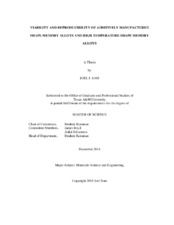| dc.description.abstract | Shape memory alloys (SMAs) are metals that can “remember” the shape they
were in before deformation and can return to that shape upon heating. These alloys have a structure that changes based on applied stress and temperature and are promising candidates for solid-state actuators in the robotics and aerospace industries.
Conventionally manufactured SMAs must undergo further processing to be formed into desired structures. With further processing there is a greater chance of introducing inclusions such as oxygen and carbon, which greatly affect the transformation temperatures of SMAs, as well as forming cracks and other structural defects. Additive manufacturing (AM) of SMAs combines alloy production and forming into a single step, reducing extraneous processing steps. AM SMAs do not currently perform as well mechanically as their conventionally manufactured counterparts. Tensile shape memory actuation was characterized for nickel-titanium (NiTi) SMAs fabricated using the laser powder bed fusion (L-PBF) AM process and two different sets of processing parameters in order to determine the viability of AM SMAs. While reversible tensile shape memory behavior was observed in both cases, the specimens fabricated with a shorter hatch spacing exhibited higher transformation temperatures, lower actuation strain, and lower irrecoverable strain compared to the specimens fabricated with wider hatch spacing. The actuation strain of the L-PBF samples was lower than that of conventionally manufactured NiTi SMA specimens.
High temperature shape memory alloys (HTSMAs) are a class of SMAs that have elements added to increase their transformation temperatures for use in high-temperature environments to prevent accidental actuation. The nickel-titanium-hafnium (NiTiHf) system has shown significant promise as an HTSMA with higher strength and work output than NiTi. Batches of NiTiHf produced in previous studies have shown variation in fatigue life and transformation temperatures despite similar compositions. A parameter called “actuation potential” was created to quantify hypothetical performance of each batch in actuator applications. Carbide content, precipitate size, stress-strain curves, stress-temperature phase diagrams, and transformation strain data from four batches of NiTiHf were used to search for the underlying causes of batch-to-batch variation in NiTiHf. Correlations of carbide content and precipitate size with actuation potential were observed, and hypotheses as to why these variations affect performance are proposed. | en |


